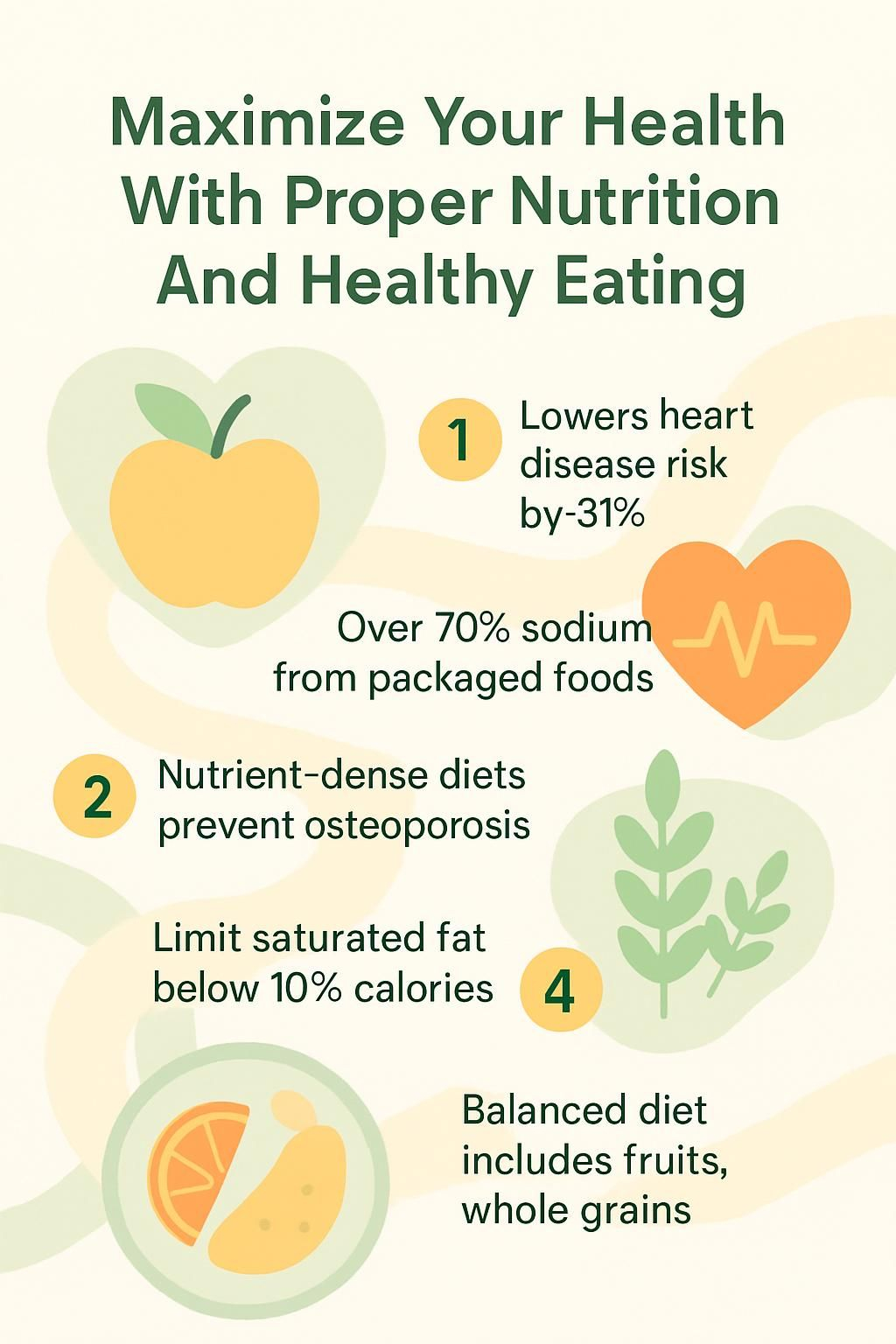Maximize Your Health With Proper Nutrition And Healthy Eating
Our Nutrition Assistant AI Suite will transform your body. You will lose fat, get toned, and build muscle. Gain confidence and optimal health.
Stress, busy days, and limited choices can make healthy eating feel difficult. Still, good nutrition gives you steady energy and protects your heart and brain. The Dietary Guidelines for Americans offer simple steps that fit real life and help you build a balanced diet.
This guide shows what to eat, how much to eat, and how to prep meals you will actually enjoy. You will learn how to use the Healthy Eating Plate, choose whole grain foods, and manage added sugars and sodium without feeling deprived.
Healthy eating starts with small, repeatable moves. Read on to find out what works.
Key Takeaways
- Good nutrition supports energy, organs, and healthy weight at every age. Eating patterns that follow national guidance can cut heart disease risk by up to 31% (Harvard Health; USDA 2020-2025).
- Build a balanced diet with fruits, vegetables, whole grains, lean protein, low-fat dairy or fortified soy, and healthy fats such as olive oil or nuts. Limit added sugars and saturated fat.
- More than 70% of U.S. sodium comes from packaged and restaurant foods. Cutting back lowers hypertension risk, according to CDC research.
- Key micronutrients matter. Calcium and vitamin D support bones. Adequate protein preserves muscle, which is vital for strength and mobility.
- Reading food labels helps you track saturated fat, added sugars, and sodium. It also supports better portion control and fewer ultra-processed choices.

What Is Proper Nutrition and Why Is It Important?

Proper nutrition means your body gets the right mix of nutrients for energy, growth, and repair. Eating well helps you maintain a healthy weight and supports daily focus and mood. It also lowers your risk of chronic conditions like heart disease and type 2 diabetes.
What are the key elements of proper nutrition?
You can build a strong foundation with simple habits. Focus on variety, quality, and balance.
- Eat a wide variety of foods from all groups, including vegetables, fruits, whole grains like brown rice and whole-wheat bread, lean meats, fish, eggs, beans, and lentils.
- Choose nutrient-dense foods, which are rich in vitamins and minerals but lower in calories, such as leafy greens, beans, nuts, yogurt, and sweet potatoes.
- Control portion sizes and pay attention to hunger cues. Large portions can lead to weight gain and raise the risk of hypertension or type 2 diabetes.
- Limit ultra-processed foods high in added sugars or saturated fat. Cut back on sugary drinks, fried foods, and desserts that add calories but few nutrients.
- Replace solid fats with unsaturated fats from olive oil, soybean oil, avocados, nuts, and salmon. This swap supports healthy cholesterol levels.
- Stay hydrated with water instead of soda or juice with added sugar. A common target is about eight cups daily unless your doctor says otherwise.
- Read food labels for sodium, added sugars, and types of fat so you can make informed choices.
- Balance your intake. Aim for 45 to 65% of calories from carbohydrates, 10 to 35% from protein, and 20 to 35% from healthy fats, consistent with U.S. guidance.
- Meet vitamin and mineral needs with a colorful diet. Include vegetables like spinach and broccoli, fruits, and dairy or fortified alternatives for calcium and vitamin D.
When I swapped packaged snacks for beans and leafy greens, my afternoon energy improved within two weeks.
Why is proper nutrition crucial for health?
Eating a healthy and balanced diet helps you keep steady energy across the day. Nutrients from vegetables and fruit, whole grains, lean proteins, and unsaturated fats support your brain, nerves, muscles, bones, skin, and blood.
Limiting salt and saturated fat, while choosing more plants and whole foods, lowers your risk of heart disease. Getting enough dietary fiber supports digestive health and has been linked to lower risk of some cancers, according to Harvard Health.
Healthy eating also protects against common age-related conditions, including type 2 diabetes, cardiovascular disease, and stroke. Older adults may absorb nutrients less efficiently, so a nutrient-dense pattern matters even more.
Helping my grandfather plan meals with more whole grains and fewer processed foods led to better digestion and more stable blood sugar in about two months.
“Food is fuel for every cell in your body, so feed yourself wisely.”
Principles for Eating a Healthy Diet
Healthy eating patterns start with everyday choices. A few core principles can guide you through busy weeks without adding stress.
How can I diversify my diet effectively?
Adding variety helps cover nutrient gaps and makes meals more satisfying.
- Fill your plate with colorful fruits and vegetables at each meal for a wide range of vitamins, minerals, fiber, and antioxidants.
- Use grains like wheat, barley, rye, corn, or rice and starchy foods like potatoes or yams to meet energy needs.
- Add legumes such as lentils, chickpeas, or beans to soups and salads for plant protein and fiber.
- Use fresh herbs in salads or pasta for flavor without extra calories.
- Make tomato and herb sauces at home to reduce sodium compared with packaged sauces.
- Top plain yogurt with fruit for an easy nutrient boost and a mix of textures.
- Cook with dark greens, whole grains, seeds, lean proteins like chicken or fish, a small amount of ghee, nuts, and vegetable oils high in unsaturated fat.
- Add diced peppers, broccoli, and onions to omelets, stews, or grain bowls for color and crunch.
- Rotate animal foods like eggs, milk, and lean meats. This helps you get enough vitamin B12 and iron for healthy cells.
- Rotate choices weekly to prevent boredom. Try kiwi one week and berries the next.
- Drink water with meals instead of sugary drinks so your cells can process nutrients without extra sugar.
Variety builds a healthier plate and keeps meals interesting, which makes healthy habits stick.
Why should I reduce processed and sugary foods?
Processed foods often deliver too much sodium, sugar, and unhealthy fat. More than 70% of the sodium in American diets comes from packaged and restaurant foods, which can raise blood pressure.
Added sugars increase the chance of obesity, type 2 diabetes, and heart disease. Fast food, soda, and processed meats add calories with few nutrients. Limiting these foods supports a healthy body weight and lowers disease risk, according to the CDC.
Experts suggest keeping added sugars under 10% of your daily calories, and under 5% is even better. Choose whole grains, fruit instead of pastries, beans instead of processed meats, and water instead of sugary drinks.
How do I select nutrient-rich foods?
Nutrient-dense foods give you more vitamins, minerals, and fiber per calorie. Use labels and simple swaps to boost quality.
- Check labels for added sugars, saturated fat, and sodium before you buy.
- Pick whole grains like brown rice, oats, and 100% whole-wheat bread to support heart health.
- Choose fruits and vegetables in many colors. Aim for half your plate, as the Harvard Healthy Eating Plate suggests.
- Use lean protein, such as fish, poultry without skin, eggs, beans, lentils, or tofu. Plant proteins also add fiber.
- Choose low-fat or fat-free milk or fortified soy beverages. Most other plant drinks lack calcium and vitamin D unless fortified.
- Include healthy fats from avocados, olive oil, nuts, and seeds. Avoid trans fats and limit saturated fat.
- Favor minimally processed foods so you get more nutrients per calorie.
- Consider supplements only if food cannot meet your needs. Ask a healthcare professional first.
These habits set you up for smart meal planning next.
How can I manage portion sizes properly?
Portion control helps prevent overeating and supports a healthy weight. Meal prep makes it easier to manage portions during busy weeks.
Use the Harvard Healthy Eating Plate as a visual guide. Fill half your plate with fruits and vegetables, one quarter with whole grains like quinoa, and one quarter with lean proteins such as chicken or beans.
Cook more meals at home for better control. Store protein-rich foods like yogurt, eggs, or nuts at eye level so you reach for them first. Pause before serving to check hunger cues, and avoid screens while eating.
People who prep meals ahead tend to eat healthier portions, which can lower the risk of overweight or obesity.
Why is hydration important for healthy eating?
Water supports your heart, kidneys, muscles, and nerves. It also helps digestion and nutrient absorption.
Choose water instead of sugary drinks to cut empty calories. Add berries or citrus to your bottle for flavor. Fat-free milk hydrates and adds protein and potassium. A small glass of 100% fruit juice can fit, but keep portions modest to limit sugar.
Carrying a reusable bottle helped me avoid late-day slumps during sports practice. Staying hydrated makes healthy eating work better.
Essential Nutrients and Their Food Sources
Your body needs carbohydrates, proteins, fats, vitamins, and minerals to function well. Eating a mix of nutrient-rich foods helps you meet daily needs without excess calories.
What are good carbohydrate sources like whole grains, fruits, and vegetables?
Carbohydrates fuel your body. Whole foods with fiber provide steady energy and help with fullness.
- Start breakfast with oatmeal or shredded wheat for fiber and lasting energy.
- Use bulgur or quinoa for meals. These complex carbs help control blood sugar.
- Make whole grains one quarter of your plate to support heart health.
- Add half a cup of beans or lentils to salads for slow-digesting carbs and nutrients.
- Top hot cereal with berries, pumpkin seeds, or almonds for extra fiber and minerals.
- Choose fresh fruit for natural sweetness and vitamin C without added sugars.
- Eat vegetables like broccoli and carrots for complex carbs and vitamins A and K.
- Include nuts and seeds for a mix of healthy fat and complex carbs.
- Pick colorful vegetables often to cover more vitamins and minerals.
- High-fiber foods keep you full longer, which helps manage calorie intake.
A broad mix of these foods supports heart health and steady energy throughout your day.
What are healthy protein options including lean meats and legumes?
Protein supports muscle, skin, and immune function. You can meet your needs with both animal and plant sources.
- Choose eggs, chicken, and seafood as lean proteins with less saturated fat. Fatty fish like salmon supply omega-3 fats.
- Add legumes such as beans and lentils to raise protein and fiber, especially in plant-forward patterns.
- Use nuts like almonds, walnuts, or pecans for plant protein and healthy fat.
- Try yogurt, especially Greek yogurt, for protein and gut-friendly cultures.
- Swap processed meats for beans or seafood to lower saturated fat and sodium.
- Sprinkle nuts or seeds on salads instead of cheese to improve fat quality.
- Grill, bake, or broil lean meats instead of frying to reduce added fat.
- Prep a weekly mix with eggs, chicken, fish, chickpeas, or tofu to simplify portions.
Mixing plant and animal proteins helps you reach goals while lowering chronic disease risk.
Which foods provide healthy fats?
Healthy fats support heart health, hormones, and cell function. Focus on unsaturated fats from plants and fish.
- Use olive oil for dressings and light cooking. It provides vitamin E and heart-friendly fatty acids.
- Choose canola, peanut, safflower, soybean, or sunflower oils to replace butter and shortenings.
- Add avocados for monounsaturated fat, fiber, and a creamy texture in smoothies or toast.
- Eat nuts and seeds, such as almonds, walnuts, chia, or flax, for healthy fats and minerals.
- Enjoy fatty fish like salmon, mackerel, trout, sardines, or tuna for omega-3 fats that reduce inflammation.
- Limit full-fat dairy and fatty meats to reduce saturated fat intake.
- Keep saturated fat below 10% of daily calories. Favor plant oils and nuts over butter or processed meats.
- Choosing unsaturated fats supports healthy cholesterol levels and energy balance.
Include small amounts of healthy fats daily to support long-term wellness.
What vitamins and minerals are essential and where can I find them?
Micronutrients keep your body running. Getting them from food supports better absorption and balance.
- Calcium strengthens bones and muscles. Sources include dairy, fortified soy drinks, canned sardines with bones, collard greens, and fortified cereals.
- Vitamin D helps you absorb calcium. Sunlight makes vitamin D, and fortified milk, soy yogurt, and mushrooms add more.
- Potassium supports heart, kidney, nerve, and muscle function. Try bananas, chard, beets, lima beans, pomegranate juice, and fat-free milk.
- Iron helps red blood cells carry oxygen. Find it in beef, chicken liver, lentils, nuts, spinach, and fortified grains.
- Vitamin C supports immunity and wound healing. Citrus, bell peppers, and strawberries are strong sources.
- B vitamins turn food into energy. Whole grains, beans, leafy greens, and meat provide many B vitamins.
- Magnesium aids muscles and bones. Spinach and black beans supply this mineral.
- Zinc supports immunity and growth. Beef and chickpeas are good options.
- Omega-3 fats support heart health. Eat salmon or sardines weekly for these healthy fats.
Knowing your best food sources makes meal planning faster and more effective.
Effective Strategies for Healthy Eating
Practical systems turn good intentions into daily action. A few routines can make healthy choices the easy choices.
How can I plan and prep meals efficiently?
Meal planning reduces stress, saves money, and helps you stick to your goals. Start small and build a routine that fits your week.
- Collect healthy recipes in a binder or digital folder for quick reference.
- Prep for two to three days at a time so food stays fresh and the task feels manageable.
- Cook time-heavy items first, such as whole grains or lean proteins, then season or marinate for later meals.
- Multitask during prep. Wash greens, chop vegetables, and portion nuts and fruit at the same time.
- Label containers with dates and use older items first. Keep perishables at eye level.
- Stock staples like frozen fish, berries, low-sodium canned beans, nut butters, oats, brown rice, quinoa, olive oil, and basic spices.
- Store ready snacks, for example sliced veggies with hummus or yogurt with fruit, in clear containers.
- Plan balanced meals with fruits and vegetables for vitamins and minerals. Add color with sweet potatoes and leafy greens.
- Check labels for saturated fat and sodium before adding canned or packaged items to your pantry.
With a routine in place, reading labels is the next smart step.
How do I understand food labels?
Start with the Nutrition Facts panel. Compare the listed serving size to what you will actually eat. A small serving can make sugar or sodium look lower than it is.
Choose products labeled low sodium, which is 140 milligrams or less per serving. Look for unsaturated oils in the ingredient list, and limit foods high in saturated fat. Pick items that list whole grains, fruits, vegetables, nuts, or legumes first.
Check total and added sugars. Keep added sugars as low as you can. Look for fiber, calcium, potassium, and iron, which many people fall short on. Fortified options, like some cereals or plant milks, can help fill gaps.
Labels also show total carbohydrates, which helps if you follow a lower-carb pattern. Reading labels helps you avoid hidden salt and unhealthy fats while choosing better options fast.
Summary: Match serving sizes to what you eat, watch sodium and added sugars, limit saturated fat, favor whole ingredients, and use fortified products to meet key needs.
What are the benefits of cooking at home?
Cooking at home gives you control over ingredients, portions, and flavor. You can use colorful produce, whole grains, and nuts instead of ultra-processed items.
Research from the CDC shows home cooking can reduce sodium intake compared with restaurant or packaged meals. Using less added sugar at home also supports heart health.
Weekend meal prep saved me time and money, and it made hitting my nutrition goals much easier. You can tailor meals to your needs and enjoy better hydration since you will have water nearby as you cook.
Why choose unsaturated fats over saturated fats?
Unsaturated fats support heart health. Saturated fat can raise LDL, the bad cholesterol, and increase heart disease risk. Keep saturated fat under 10% of daily calories.
Swap butter for olive, canola, peanut, safflower, soybean, or sunflower oils. Add nuts and seeds to salads instead of cheese. Use low-fat yogurt or avocado for creaminess in smoothies. Choose beans or seafood instead of processed meats.
I replaced bacon in breakfast wraps with grilled salmon and swapped cheese for pumpkin seeds on salads. My energy improved within a few weeks.
How can I minimize sodium in my diet?
Sodium affects blood pressure, so lowering intake supports heart health. Most sodium comes from packaged and restaurant foods, not the salt shaker.
Choose items labeled low sodium and cook more meals at home with fresh ingredients. Use lemon juice, garlic, herbs, and salt-free spice blends for flavor. If you add salt, measure it rather than shaking freely.
My family saw blood pressure improvements after shifting from canned soups and frozen dinners to simple home-cooked meals with fresh produce and lean proteins.
What Are the Health Benefits of Proper Nutrition?
Food choices shape your energy, immunity, digestion, and long-term health. Think of meals as daily support for every system in your body.
How does nutrition boost energy levels?
Carbohydrates, proteins, and fats power your day. Whole grains, fruits, and vegetables digest slowly and provide steady fuel. Energy crashes often follow skipped meals or heavy intake of sugary snacks.
Nutrient-dense foods keep your energy steady. Meal prep prevents last-minute choices that drain energy. Even mild dehydration can cause fatigue, so keep water nearby.
How does proper nutrition support immune function?
Vitamins and minerals help your immune cells work properly. Vitamin C from citrus, zinc from beans or beef, and vitamin D from fortified milk support defense against infections.
Plant foods supply antioxidants that protect cells. Yogurt with live cultures adds probiotics, which support gut health and immunity. Deficiencies in key micronutrients can weaken your defenses.
I felt fewer winter colds after adding more colorful vegetables and yogurt to my lunches.
How can nutrition promote digestive health?
Fiber from fruits, vegetables, whole grains, legumes, nuts, and seeds supports regularity and helps control blood sugar. Increase fiber gradually and drink water to limit bloating.
Probiotic foods like yogurt help maintain a healthy gut. Limiting ultra-processed foods reduces the risk of digestive discomfort and supports a diverse gut microbiome.
How does nutrition lower the risk of chronic conditions?
Healthy digestion supports overall wellness, but your food pattern does even more. Limiting added sugars and saturated fats reduces the risk of obesity, type 2 diabetes, and heart disease.
Eating more vegetables, fruits, and whole grains provides fiber and antioxidants that protect cells. Healthy fats from olive oil and fatty fish support heart health. Lowering sodium helps protect against hypertension, heart attack, and stroke. Potassium-rich foods can help reduce blood pressure and may lower kidney stone risk.
How does proper nutrition strengthen bones and muscles?
Calcium and vitamin D are vital for strong bones. Low-fat dairy, lactose-free milk, or fortified soy drinks are reliable sources. Canned salmon and sardines with bones provide calcium too. Leafy greens add plant-based options.
Protein from lean meats, fish, legumes, and dairy supports muscle. Vitamin D helps your body use calcium well. A daily mix of these foods builds a strong base for bone density and muscle strength as you age.
Nutritional Needs for Different Life Stages and Lifestyles
Nutrient needs change with age, activity level, and life events. Adjust your plan to fit your stage and goals.
What are children’s nutritional guidelines?
Children need enough energy and nutrients for growth and brain development. These steps align with global guidance.
- Exclusive breastfeeding from birth to 6 months supports growth and immunity.
- At 6 months, add complementary foods while continuing breastfeeding. Offer cereals, tubers, legumes, fruits, vegetables, and animal foods as appropriate.
- Increase fruit and vegetable portions over time to supply vitamins, minerals, and fiber.
- Avoid sugary drinks and sweets. Serve fresh fruit for snacks.
- Limit salt to less than 5 grams per day to support healthy blood pressure later.
- Watch portion sizes to avoid underfeeding or overfeeding.
- Offer variety, including whole grains, lean proteins, healthy fats from nuts or fish, and dairy as appropriate.
- Use safe feeding practices, such as handwashing and thorough cooking.
- Good early nutrition lowers the risk of obesity and chronic disease later.
- Track intake and growth to support well-being through childhood.
What should older adults consider in their nutrition?
As you age, nutrient density matters more. These habits support independence and quality of life.
- Prioritize calcium and vitamin D for bone health. Use low-fat dairy, fortified foods, or supplements as advised.
- Get quality protein from lean meats, fish, legumes, and dairy to maintain muscle after 50.
- Increase fiber from whole grains, vegetables, and fruits to support digestion.
- Limit sodium by checking labels and cooking more at home. Aim for less than 2,300 mg per day.
- Fill nutrient gaps with a balanced diet. Consider fortified foods or supplements if needed.
- Drink water regularly, since thirst may decline with age.
- Plan meals ahead to avoid reliance on high-sugar or high-fat processed foods.
- Consult a registered dietitian for advice tailored to medications and conditions.
What are athlete dietary requirements?
Active bodies need enough fuel for training and recovery. Plan intake around workouts.
- Get 10 to 35% of calories from protein, such as lean meats, fish, eggs, beans, or nuts, to repair muscle.
- Get 45 to 65% of calories from carbohydrates like whole grains, fruits, and vegetables to meet energy needs.
- Include 20 to 35% of calories from healthy fats, such as nuts, seeds, avocados, and olive oil.
- Hydrate before, during, and after activity. Water works for most sessions. Use electrolyte drinks for long or intense workouts if needed.
- Use meal planning and portions to meet needs without overeating.
- Watch sodium intake unless your healthcare provider advises more due to heavy sweating.
- Choose nutrient-dense foods to support bones, muscles, and overall health through your training cycle.
What nutritional care is needed during pregnancy?
During pregnancy, your nutrition supports both you and your baby. Focus on a balanced pattern and key nutrients.
- Get calcium and vitamin D from fortified dairy, eggs, and sardines to support fetal bone growth.
- Choose iron-rich foods like lean meats, spinach, and legumes to meet higher blood volume needs.
- Eat foods with folate, such as beans, lentils, and leafy greens, to reduce the risk of neural tube defects.
- Stay well hydrated and limit sugary drinks.
- Plan balanced meals with protein, whole grains, fruits, vegetables, healthy fats, and dairy or fortified alternatives.
- Keep sodium in check and limit added sugars and saturated fats.
- Schedule check-ins with a qualified professional for personalized prenatal guidance.
When and How Should You Use Dietary Supplements?
Supplements can help when food alone is not enough. Start with a food-first plan, then use testing and medical advice to guide decisions.
When are supplements necessary?
Supplements are useful when a confirmed deficiency is present, such as iron or vitamin D. They may also help when medical conditions limit absorption, including some digestive disorders, osteoporosis, or lactose intolerance.
People who avoid all animal foods often need vitamin B12. Older adults sometimes need targeted supplements due to absorption changes. Always consult your clinician before starting any product.
What are key vitamins and minerals to consider for supplementation?
Testing helps you target what you truly need. These are common gaps.
- Vitamin D supports bones and may require supplementation in people with little sun exposure or darker skin.
- Calcium can support bone strength if you cannot meet needs with dairy or fortified foods.
- Vitamin B12 is essential for nerves and red blood cells. Strict vegans and some people with gut issues may need it.
- Iron helps prevent anemia. Pregnant women, menstruating teens, and those with iron deficiency often need extra.
- Multivitamins can help when multiple deficiencies are present, but they are not a replacement for a balanced diet.
- Fortified foods, like cereals and plant milks, can fill gaps in vitamin D and calcium without pills.
- Work with a healthcare professional to set safe doses and avoid interactions.
Why should you consult health professionals about supplements?
Professional guidance prevents overuse, side effects, and harmful combinations with medicines. A clinician can confirm if you need a supplement, recommend trusted brands, and set the right dose.
During my nutrition coaching training, I met clients who took several products without guidance and developed headaches from excess vitamin B6. A tailored plan fixed the problem within weeks.
Regular monitoring keeps your plan safe and effective. Personalized advice matters when you have chronic conditions or take daily medications.
How to Avoid Common Nutritional Mistakes
A few common pitfalls can stall progress. With small changes, you can avoid them and feel better day to day.
How can I prevent overeating and undereating?
Use the Healthy Eating Plate to build balanced portions. Eat slowly and stop when comfortably full. Prepping meals helps you track portions and avoid large takeout servings.
Keep produce and other fresh items at eye level in the refrigerator so you choose them first. Skipping meals can trigger overeating later. Labeling and dating prepped foods also reduces mindless snacking.
Why limit reliance on processed foods?
Processed foods tend to be high in added sugars, unhealthy fats, and sodium. These can raise the risks for weight gain, heart disease, diabetes, and some cancers.
Whole foods deliver vitamins, minerals, fiber, and antioxidants that protect your health. Water hydrates without the sugar and calories found in many packaged drinks.
Years ago, I swapped breakfast pastries for oatmeal with fruit. My morning focus and energy improved quickly.
Why avoid meal skipping and crash diets?
Skipping meals and crash diets leave nutrient gaps and often lead to rebound weight gain. They strain your metabolism and can create unhealthy patterns.
A steady routine with whole grains, fruits, vegetables, lean proteins, and healthy fats provides what your body needs. Meal planning supports consistent choices and long-term health.
Meal Preparation Tips for Healthy Eating
With a few smart moves, you can put nutritious meals on the table fast. Keep it simple and repeat what works.
What are some simple and quick meal ideas?
Quick meals can be healthy and satisfying. Try these easy options.
- Start breakfast with oatmeal and banana slices for fiber and steady energy.
- Snack on sliced carrots or bell peppers to boost vitamins between meals.
- Add cooked beans or lentils to salads for protein and minerals in minutes.
- Drink fortified dairy or soy with meals to increase calcium and vitamin D.
- Heat canned beets or steam lima beans for a fast, nutrient-rich side.
- Serve baked chicken, whole-grain rice, and steamed broccoli for balance.
- Infuse water with citrus or berries for flavor without added sugar.
- Draft a weekly plan using quick-to-prepare staples so healthy eating feels easy.
How can I incorporate diverse nutrients and colors in meals?
Color is a quick way to judge variety. Different colors often equal different nutrients.
- Build plates with red peppers, spinach, carrots, blueberries, and oranges for a wide nutrient spread.
- Choose whole grains like brown rice, oats, and quinoa for fiber and fullness.
- Add lean proteins, such as grilled chicken, fish, tofu, eggs, or legumes.
- Sprinkle almonds or chia seeds on yogurt or salads for healthy fats and crunch.
- Fill half your lunch or dinner plate with vegetables to boost phytonutrients.
- Use herbs like parsley or cilantro for bright flavor and added greens.
- Mix beans of different colors into soups or grain bowls for variety.
- Keep diverse staples on hand so you always have colorful options.
- Trade sugary snacks for fruit plus a handful of nuts to steady energy.
Planning your next grocery list around color and variety turns these ideas into daily habits.
How do I create budget-friendly healthy meals?
Healthy eating does not have to be expensive. A little planning stretches both your dollars and your nutrition.
- Choose a weekly planning day. Make a menu before you shop.
- Buy versatile staples like bulk rice, canned beans, frozen vegetables, oats, and eggs.
- Pick in-season produce for better prices and taste.
- Cook larger batches for two or three days to save time and money.
- Use smaller plates and save leftovers for tomorrow instead of wasting food.
- Build mixed dishes like stir-fries and grain bowls to use what you have.
- Multitask. Chop vegetables or marinate protein while another dish cooks.
- Choose recipes with overlapping ingredients to prevent spoilage.
- Drink tap water instead of sugary drinks to save money and calories.
- Make simple meals at home like veggie omelets or roasted chicken with root vegetables.
These steps protect your budget while keeping nutrition front and center.
How Does Physical Activity Support Nutrition Goals?
Movement and healthy eating work better together. Each supports the other for stronger results.
How does exercise complement nutritional goals?
Exercise helps your body use nutrients more efficiently. After workouts, muscles absorb protein better, which supports repair and growth.
Regular activity burns energy and helps manage weight when paired with balanced meals. Eating a protein-rich meal after strength training improved my recovery and next-day performance.
How do I balance calorie intake and expenditure?
Track your intake and your activity to keep energy in balance. Choose nutrient-dense foods so portions stay reasonable.
A 30-minute brisk walk may use about 150 calories. A balanced lunch with vegetables, grilled chicken, and brown rice supports both energy and nutrition goals. Simple apps can help you log meals and estimate activity.
Meal prepping kept me from overeating after long workdays. Monitoring intake and output helps keep energy steady across the week.
Conclusion
Daily choices add up. Focus on healthy eating with fruits, vegetables, whole grains, lean proteins, and low-fat dairy or fortified plant options. Choose quality fats, limit added sugars and saturated fat, and be mindful with sodium.
Plan colorful, balanced meals that meet what your body needs. This approach supports energy, bone health, and muscle strength across life stages. For national guidance, see the Dietary Guidelines for Americans.[1]
This article is for education only. For medical advice or a personalized nutrition plan, talk with a qualified healthcare professional.
[1] U.S. Department of Agriculture & U.S. Department of Health and Human Services. Dietary Guidelines for Americans 2020–2025.
FAQs
1. What are the main benefits of proper nutrition and healthy eating for overall health?
Proper nutrition supports immune function, helps maintain a healthy weight, reduces risk of chronic diseases such as heart disease and diabetes, and improves energy levels. According to the Centers for Disease Control and Prevention, balanced meals rich in fruits, vegetables, whole grains, lean proteins like poultry or fish, and low-fat dairy can lower blood pressure by up to 11 mm Hg.
2. How do I know if my diet meets recommended nutritional guidelines?
Compare your daily intake with guidelines from reputable sources such as the Dietary Guidelines for Americans. For example, adults should aim for at least five servings of produce each day; limit added sugars to less than 10 percent of total calories; choose whole grain bread instead of white bread; select lean meats over processed options; and include beans or lentils regularly.
3. Can you share a personal experience that highlights the impact of healthy eating?
After switching from fast food lunches to home-prepared salads with grilled chicken breast or tuna twice per week last year, I noticed improved focus during work hours and fewer afternoon energy crashes. This change also helped me lose seven pounds over three months without feeling deprived.
4. What is an easy way to start improving my eating habits today?
Begin by making small changes such as swapping sugary drinks for water or unsweetened tea at lunch; adding one serving of leafy greens like spinach or kale to dinner plates; choosing brown rice instead of white rice once per week; or preparing snacks using yogurt paired with berries rather than chips.
Summary: Proper nutrition offers many health benefits including disease prevention and better energy levels. Following trusted dietary guidelines helps ensure nutrient needs are met while simple swaps make it easier to adopt healthier habits every day.







